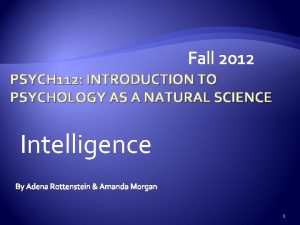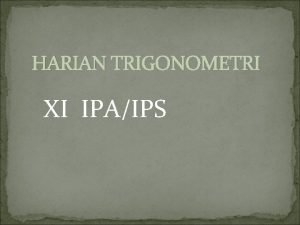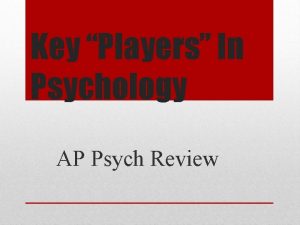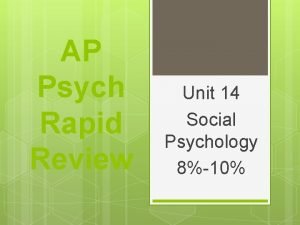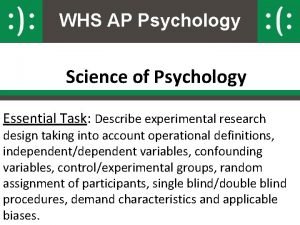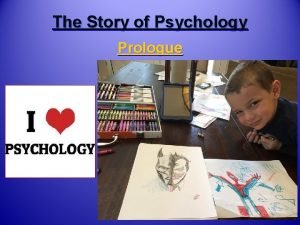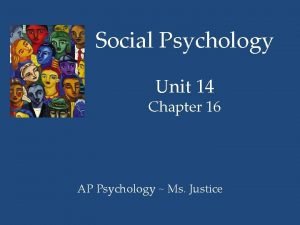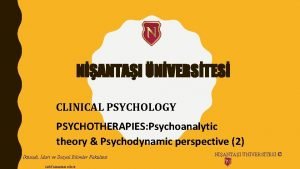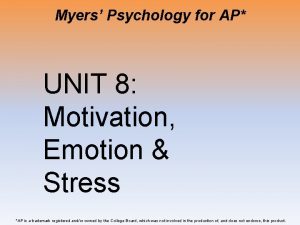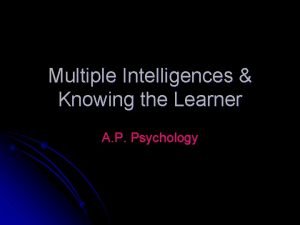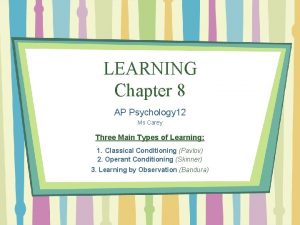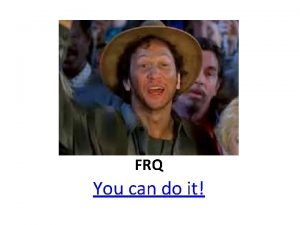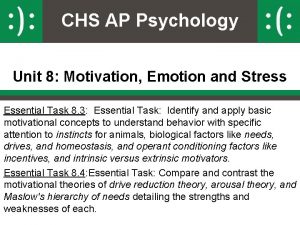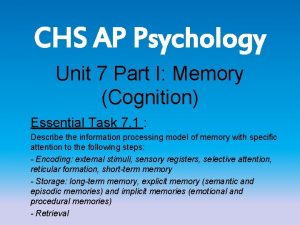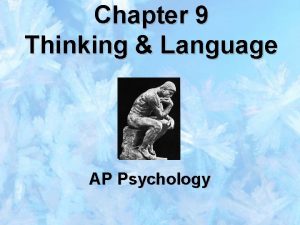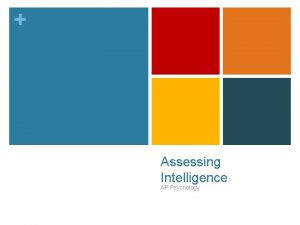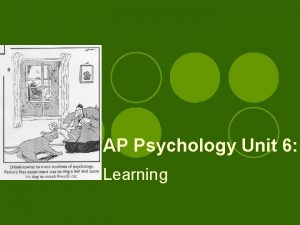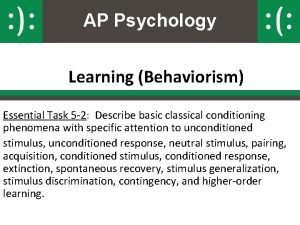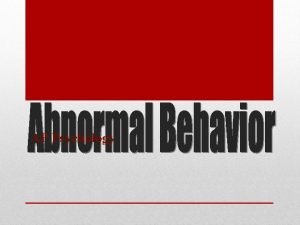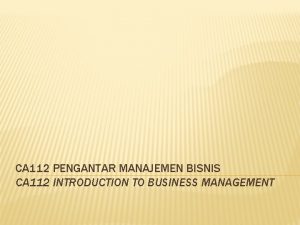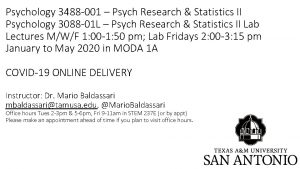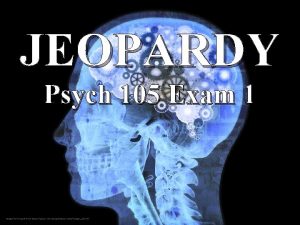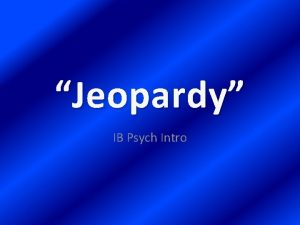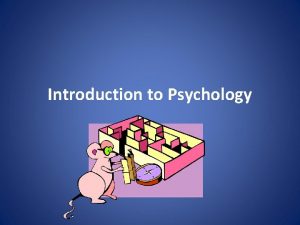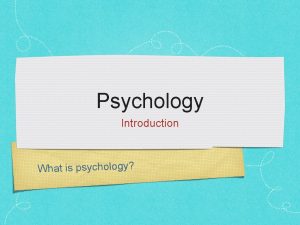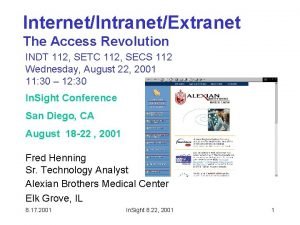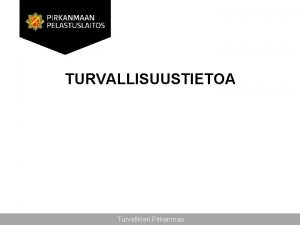PSYCH 112 INTRODUCTION TO PSYCHOLOGY AS A NATURAL


























- Slides: 26

PSYCH 112: INTRODUCTION TO PSYCHOLOGY AS A NATURAL SCIENCE Intelligence 1

Learning Objectives After this lesson you should… • • • Understand the origins of mind (evolutionary) view on intelligence Be familiar with the history of intelligence testing in the United States Be able to identify the components of Howard Gardner ‘s Multiple Intelligences Theory 2

Origins of Mind • The structure and functions of our brains evolved to better function in specific, local environments over tens of thousands of years • Our brains allow us to: • Use tools (object manipulation) • Modify our surroundings (problem solving) • Transmit information through language & culture • These abilities give us a competitive edge in our environment which allowed us to better survive and reproduce 3

In-Class Activity: Intelligence Test Please complete the following 10 -question intelligence test When finished, think about the following questions: How many answers were you sure/unsure of? Do the questions you were sure of differ from the ones you were unsure of? Why do you think that is ? (your answer to the previous question) 4

In-Class Activity: Intelligence Test Answers: 1. “Many” 2. “Very many” 3. “Tree” 4. Marine turtle, brolga, and frilled lizard 5. All of them 5

In-Class Activity: Intelligence Test Answers: 6. “Eat” 7. (b) Harry 8. (e) Someone 9. (c) Small female wallaby 10. Because some of them have to be avoided like the plague (poison cousins) 6

In-Class Activity: Intelligence Test Discussion: How well did you do? Why do you think that is? 7

In-Class Activity: Intelligence Test Conclusion: What we consider intelligence, and how we measure that intelligence varies by our cultural contexts. 8

History of Intelligence Testing in the United States It all begins in France… Alfred Binet and Henri Simon Designed to identify slower learners in need of extra assistance (to help them catch up to their peers) Diverse content: Object naming Word meanings Drawing pictures from memory Completing sentences 9

History of Intelligence Testing in the United States Enter Lewis M. Terman, a young American psychologist He argues that intelligence: Is hereditary or fixed at birth Does not change over time Determined primarily by the groups one belongs to Race Class Gender 10

History of Intelligence Testing in the United States Excerpt from scoring instructions (1916): Show the image “Dutch Home” Say: " What is this picture about ? What is this a picture of? " Use the double question, and follow the formula exactly. Satisfactory responses: "It's about Holland. The little Dutch girl is crying and the mother is sitting down. “ "A little Dutch girl and her mother and that's a kitten, and the little girl has her hand up as if she was doing something to her forehead. She has shoes that curve up in front. " "Dutch lady, and the little baby doesn't want to come to her mother and the cat is looking for some mice. " 11

History of Intelligence Testing in the United States Large differences were found across racial groups, genders, and social classes This was not perceived as a flaw in the study, but a validation of its effectiveness Quote from Terman: “High-grade or border-line deficiency… is very, very common among Spanish-Indian and Mexican families of the Southwest and also among negroes. Their dullness seems to be racial, or at least inherent in the family stocks from which they come… Children of this group should be segregated into separate classes… They cannot master abstractions but they can often be made into efficient workers… from a eugenic point of view they constitute a grave problem because of their unusually prolific breeding” 12

History of Intelligence Testing in the United States Terman’s work becomes widely successful It was used to: Forcibly remove children with lower scores from their families and place them in institutions for the “feeble-minded” Restrict immigration from countries deemed less intelligent Justify racial segregation and other race-based injustice Legally require the sterilization of low-IQ people (mostly poor women of color) These procedures were done without consent* Estimated that there were at least 66, 000 forced sterilizations during this time 13

History of Intelligence Testing in the United States The Stanford-Binet IQ Test is still the mostly widely used and accepted form of intelligence testing to this day (On its 5 th revision) However, there have been other models of intelligence proposed 14

In-Class Activity Complete the following 32 -question test of intelligence Make note of any patterns you see within the questions, e. g. what themes are emerging? 15

Multiple Intelligences Howard Gardner (1983) 8 separate intelligences 1. Linguistic 2. Logical-mathematical 3. Spatial 4. Musical 5. Bodily-Kinesthetic 6. Interpersonal 7. Intrapersonal 8. Naturalistic Existential – we don’t cover this 16

Multiple Intelligences Howard Gardner (1983) 8 separate intelligences 1. Linguistic – being sensitive to words and sounds and the use of language 2. Logical-mathematical 3. Spatial 4. Musical 5. Bodily-Kinesthetic 6. Interpersonal 7. Intrapersonal 8. Naturalistic 17

Multiple Intelligences Howard Gardner (1983) 8 separate intelligences 1. Linguistic 2. Logical-mathematical – Seeing number patterns and following an argument 3. Spatial 4. Musical 5. Bodily-Kinesthetic 6. Interpersonal 7. Intrapersonal 8. Naturalistic 18

Multiple Intelligences Howard Gardner (1983) 8 separate intelligences 1. Linguistic 2. Logical-mathematical 3. Spatial – Understanding the visual world and responding well to it 4. Musical 5. Bodily-Kinesthetic 6. Interpersonal 7. Intrapersonal 8. Naturalistic 19

Multiple Intelligences Howard Gardner (1983) 8 separate intelligences 1. 2. 3. 4. 5. 6. 7. 8. Linguistic Logical-mathematical Spatial Musical – Hearing and making sounds in rhythm in music Bodily-Kinesthetic Interpersonal Intrapersonal Naturalistic 20

Multiple Intelligences Howard Gardner (1983) 8 separate intelligences 1. 2. 3. 4. 5. Linguistic Logical-mathematical Spatial Musical Bodily-Kinesthetic – Controlling the body and handling objects 6. Interpersonal 7. Intrapersonal 8. Naturalistic 21

Multiple Intelligences Howard Gardner (1983) 8 separate intelligences 1. 2. 3. 4. 5. 6. Linguistic Logical-mathematical Spatial Musical Bodily-Kinesthetic Interpersonal – Being sensitive to feelings of others and responding well 7. Intrapersonal 8. Naturalistic 22

Multiple Intelligences Howard Gardner (1983) Nine separate intelligences Linguistic Logical-mathematical Spatial Musical Bodily-Kinesthetic Interpersonal Intrapersonal – Understanding your own feelings and controlling your own behavior Naturalistic 23

Multiple Intelligences Howard Gardner (1983) 8 separate intelligences 1. 2. 3. 4. 5. 6. 7. 8. Linguistic Logical-mathematical Spatial Musical Bodily-Kinesthetic Interpersonal Intrapersonal Naturalistic – Recognizing and classifying flora and fauna 24

In-Class Activity Go back to your 32 item worksheet We’ll work together as a class to determine which questions relate to each of the intelligences Gardner proposed Calculate your total score for each of the intelligences Scores of 0 are low Scores of 8 are average Scores of 16 are high 25

In-Class Activity: Discussion What did you score highly on? What did you score lowly on? Which of these intelligences are captured by standard intelligence testing, e. g. IQ, SAT, etc. ? Is there any type of intelligence missing from this test that you would like to add? 26
 Intelligence testing
Intelligence testing 6 sin 112,5° sin 22,5°
6 sin 112,5° sin 22,5° Positive psychology ap psych
Positive psychology ap psych Ap psych social psychology
Ap psych social psychology Double blind procedure ap psychology
Double blind procedure ap psychology Frankston psych ward
Frankston psych ward William james known for
William james known for Frustration-aggression principle
Frustration-aggression principle Social trap
Social trap Ucf psi chi
Ucf psi chi Transference psychology
Transference psychology Unit 8 myers ap psychology
Unit 8 myers ap psychology Howard gardner ap psych
Howard gardner ap psych Lazarus ap psych
Lazarus ap psych Ms carey ap psych
Ms carey ap psych Jmu psych checklist
Jmu psych checklist Sodas ap psychology
Sodas ap psychology Near-death experiences are ap psych
Near-death experiences are ap psych Instinct ap psych definition
Instinct ap psych definition Psych unit 7
Psych unit 7 Ap psych thinking and language
Ap psych thinking and language Alfred binet ap psychology
Alfred binet ap psychology Habituation ap psych
Habituation ap psych Ap psych sensation and perception
Ap psych sensation and perception Behaviorism ap psych
Behaviorism ap psych Antisocial personality disorder ap psychology definition
Antisocial personality disorder ap psychology definition Habituation psychology definition
Habituation psychology definition
